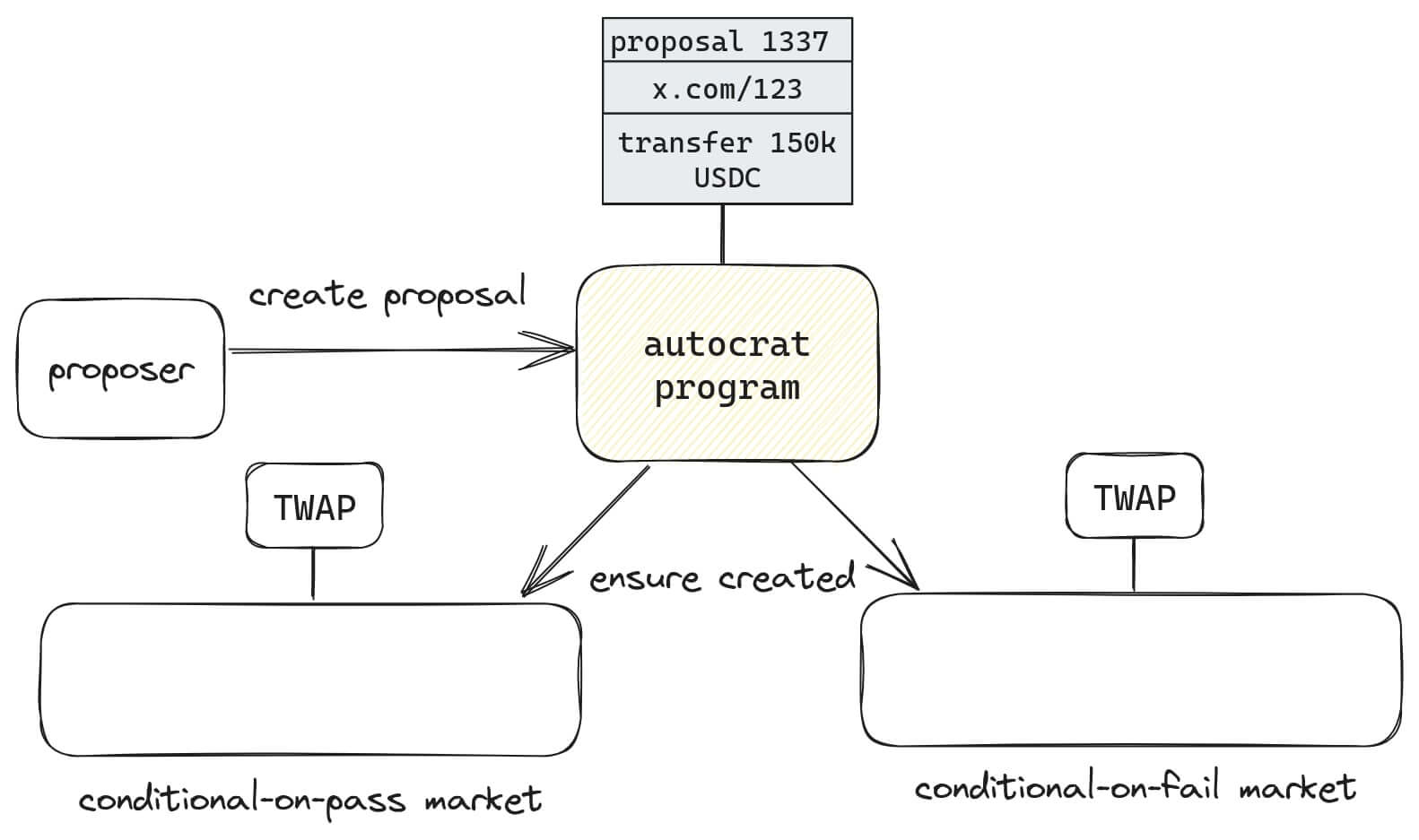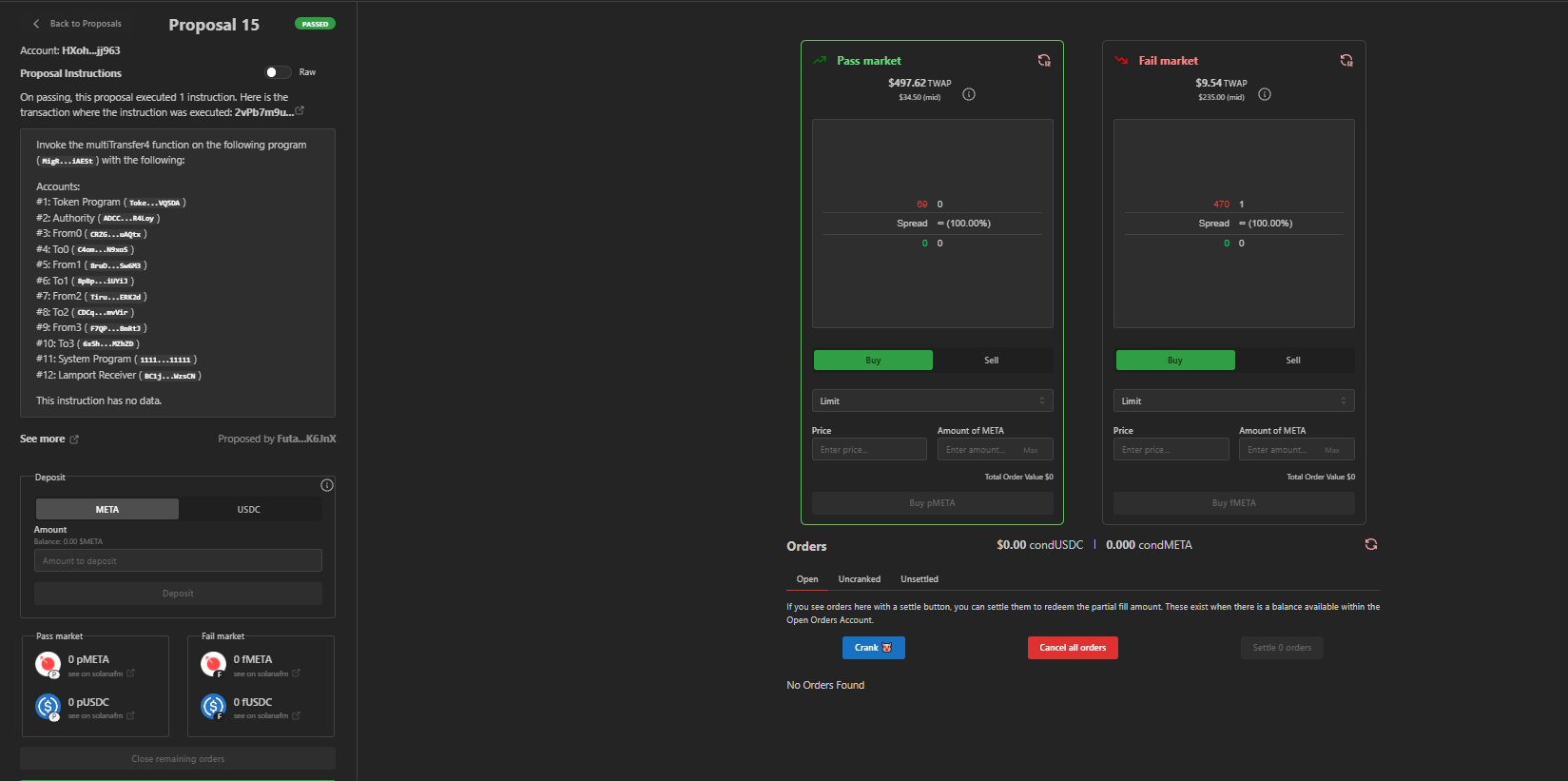Modern governance systems can be flawed and riddled with poor decision-making due to human error at high levels of varying organizations. Whether it's a small community or a large nation, making decisions that benefit the collective while considering diverse perspectives is complex and difficult.

Traditional governance systems often rely on elected officials or appointed leaders to make these decisions, but what if there was a more efficient and transparent way to govern? Enter futarchy, a new concept that seeks to revolutionize governance models by leveraging prediction markets to make decisions.
In this article, we'll explore the concept of futarchy, its principles, and applications, with a specific focus on how the project MetaDAO is incorporating it into its decentralized governance framework.
Understanding Futarchy
Futarchy, a term coined by economist Robin Hanson in 2000, combines elements of democracy and betting markets to create a unique decision-making system. At its core, futarchy relies on prediction markets to determine the best course of action for a given decision. Unlike traditional voting systems where individuals cast ballots based on their preferences, prediction markets allow participants to bet on the likelihood of future events or outcomes.
The fundamental premise of futarchy is simple yet powerful: decision-makers propose policies or actions, and prediction markets are set up to determine the expected consequences of those decisions. Participants trade shares based on their beliefs about the outcomes, with prices reflecting the aggregated thoughts of the crowd. Once the decision is made and the outcome observed, the market resolves and the results inform future governance choices.
MetaDAO: Integrating Futarchy into Decentralized Governance
Built on Solana, MetaDAO is the first application of a futarchy in real practice, branding itself as, “An organization governed by markets, not politics”. Through transparent and efficient decision-making mechanisms, the MetaDAO aims to cultivate an environment conducive to innovation and collaboration, empowering individuals to contribute to the advancement and development of Web3 technologies.
The success of futarchy in the MetaDAO is based on the belief that since asset prices in an efficient market reflect all known information at any given time, they should provide the best prediction of future events based on all available current knowledge.
Members of the MetaDAO are branded as “futards”, or one who participates or associates themselves in futarchy. A core group of futards act as the main contributors to the MetaDAO, as they continue to look for more support across Social Media, Marketing, Philosophy, Onboarding, Engagement, and Research.
Futards can be classified within 3 general roles within the DAO, each making specific contributions to its ongoing success.
- Analysts
- “Thinkers” of the MetaDAO
- Actively trading markets
- Can intensely study a situation, prioritizing reason over emotions in their verdicts
- Entrepreneurs
- “Action-takers” of the MetaDAO
- Take on major projects and build teams
- Needs to be able to convince analysts of project strength, and convince cyber-agents to join their team
- Risk-takers
- Cyber-Agents
- “Builders” of the MetaDAO
- Coders, engineers, designers, marketers
The combined synergies between analysts, entrepreneurs, and cyber-agents are what will make MetaDAO successful in using futarchy as a governance model.
So, how does MetaDAO incorporate futarchy into its decentralized governance framework? Let's break down the 3 different open-sourced programs that MetaDAO is composed of:
- Conditional Vault Program
- Tied to a specific underlying token (META/USDC) and settlement authority (MetaDAO)
- Simulates transaction reversion, allowing MetaDAO participants to use conditional tokens to redeem underlying tokens after proposal finalization
- Contains Pass & Fail Vaults/Markets
- Time-Weighted Average Price (TWAP) Program
- Determines the fair market value of the conditional tokens traded within a given conditional market
- Ensures the governing process is represented by the most accurate price within a set time
- Autocrat Program
- Orchestrates futarchy by initializing proposals within MetaDAO
- Creates requisite conditional vaults & markets after each proposal When
proposal finalization is triggered, the TWAP of each conditional market is
checked, and either finalizes or reverts the pass/fail markets based on which
is higher
- For example, if someone mints conditional-on-pass META and trades it for conditional-on-pass USDC, either the proposal will pass and they can redeem conditional-on-pass USDC for USDC, or the proposal will fail and they can redeem their conditional-on-fail META for their original META. (MetaDAO Docs)

Participating in the MetaDAO
Being an active futard and contributor is an easy process to start, with a wide array of options to choose how you want to participate whether you’d like to be an analyst, entrepreneur, or cyber-agent.
One of the most common forms of participation is trading the conditional markets of proposals going through the DAO. Trading these markets directly reflects your beliefs about the DAO, and how it should properly allocate its time and resources to the right initiatives.
To participate in trading these conditional markets, you will need to obtain $META through a DEX platform, and then use those tokens to mint your conditional tokens which are then used to vote on the proposals.

Aside from participating in trading the conditional markets for proposals, futards can also participate in the MetaDAO by creating proposals using the MetaDAO proposal templates, improving areas of the MetaDAO’s codebase, or creating marketing materials surrounding the protocol or proposals!
Benefits of Futarchy in MetaDAO
With its different approach to DAO governance, the integration of futarchy into MetaDAO's governance framework aims to offer several key benefits over other frameworks:
-
Transparency and Accountability: By basing decisions on prediction markets, MetaDAO can ensure more transparency in the decision-making process. Participants can see the rationale behind each decision and understand the factors driving them.
-
Efficiency: Futarchy streamlines the decision-making process by leveraging the collective intelligence of the community. Instead of relying on lengthy debates or subjective opinions, decisions are informed by market signals, leading to more efficient outcomes.
-
Incentive Alignment: Participants in MetaDAO have a direct financial stake in the outcomes of proposed initiatives. This alignment of incentives encourages thoughtful analysis and decision-making, as individuals seek to maximize their returns by accurately predicting future outcomes. With other types of DAO participation typically poor, futarchy gives participants extra incentives to be active on proposals, as they are strongly incentivized to correct mispricings for financial gains.
-
Adaptability: Futarchy allows the MetaDAO to adapt and respond quickly to changing circumstances. If a proposed initiative is not achieving its desired outcomes, the prediction markets provide early warning signals, allowing the community to course-correct or reallocate resources as needed.
Conclusion
Futarchy represents a new paradigm shift in experimental governance models, offering a data-driven approach to decision-making that prioritizes transparency, efficiency, and collective intelligence. By integrating the principles of futarchy into its decentralized governance framework, MetaDAO is paving the way for a new model of organizational management in the Web3 space. As futarchy continues to evolve and mature, its potential applications may extend far beyond blockchain and cryptocurrency, offering a compelling model for governance in diverse contexts around the world. With MetaDAO leading the charge, we can’t wait to watch the first futarchy in practice!
Be sure to join the MetaDAO Discord for more information on how to get involved, and dive into their docs for more information on futarchy and how the MetaDAO works!

